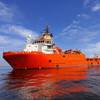Stern Landing Vessels (SLV's) are a uniquely designed vessel from Sea Transport Solutions, vessels which incorporate a number of outstanding features to adequately answer problems inherent in conventional craft. `The vessels offer not only a breadth of opportunity and operational flexibility for owners, but provide significant benefits for builders wishing to capture a unique passenger/utility/container/RoRo niche.
The SLV was conceived as a relatively easy-to-build vessel, able to address many operational challenges facing traditional craft. For example, problems such as:
-- Head seas: which can cause slamming, jarring and result in significant speed reduction;
-- Poor visibility: as the bow ramp of some vessels, in the stow position, can create blind spots from the wheelhouse;
-- Machinery placement: the wheelhouse on top of the machinery can cause breakdowns in concentration and fatigue due to noise and vibration; and
-- Beaching/de-beaching: traditional vessels can frequently encounter difficulty, particularly when the bow has grounded.
-- Lack of deadweight: limited by the relatively low profile of the GZ curve, or a relatively small righting lever, the small freeboard and the free surface of numerous below deck flat bottom tanks.
Positioned as the "solution" is the SLV, a product that ASDMAR claims is a better alternative with several working case studies as examples. The SLV incorporates a shallow V hull with two side pods. The side pods house the engines, helping to improve the vessels righting ability. Together, with off center shafts and a beaching/protection/aft skeg arrangement, the design is positioned as an unbeatable landing craft design.
Maneuverability
When working across a current to a beach landing, the SLV can be beached in two ways:
-- Anchoring upstream of the ramp and simultaneously paying out the cable while steering the vessel into the ramp;
-- Fitting a bowthruster, and approaching the ramp and landing the ramp in a similar manner to a conventional landing craft, but using the bowthrust to keep the head up into the current or wind.
With the propellers being at the outside extremities of the vessel, the steering is very easy both ahead and astern. The steering is enhanced by using Shilling Rudders or, alternatively, azimuth drives can be used. Skegs protect the stern gear from beach landings.
Vessel maneuverability proved to be one of the trickier developments with the SLV. In initial designs, when the propeller and rudder were moved slightly forward, the team encountered steering difficulties in constant helm over correction. After more model testing, the problem was rectified with fixed rudder plates aft which were incorporated into the beaching skegs. This had the dual advantage of rectifying the steering problem and strengthening the beaching skeg.
Another problem encountered in the initial stages revolved around the propellers, which were so far outboard that small angles of roll would bring them close to the surface, resulting in the propellers "sucking" air from above and forward, causing them to cavitate freely with rpm's going over the top. This problem did not appear until the fourth vessel, as the first three were working exclusively in smooth waters. The problem was fixed with a series of cavitation plates.
It is little secret that the maritime industry is often conservative in the acceptance of new designs, particularly when it's a beaching design, which places the stern gear towards a shoaling beach. However, there is a long reference list of successful vessels in operation -- including SLV Lana, which demonstrates the SLV design five times daily -- which prove that an SLV can rapidly approach a concrete ramp stern first, without endangering the stern gear of the vessel.
Sponsored Content
Experience Custom Yacht Signs and Designs Tailored to Perfection!

April 2025
 Read the Magazine
Read the Magazine

 Read the Magazine
Read the Magazine
This issue sponsored by:

OPINION: Hold the Bricks, Start the Discussion on the Future of Domestic Shipbuilding
Subscribe for
Maritime Reporter E-News
Maritime Reporter E-News is the maritime industry's largest circulation and most authoritative ENews Service, delivered to your Email five times per week








